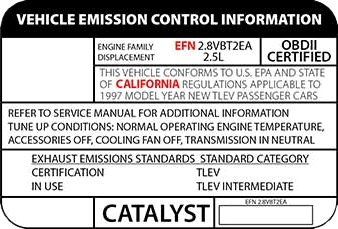Selecting the Right Converter
Where your vehicle is registered will determine what type of catalytic converter you’re legally permitted to purchase, install and use.
To learn more about government regulations around emission standards in California, Maine, New York or all other states (Federal). Please see the following external sources:
California emission standards
Maine emission standards
New York emission standards
Federal emission standards
For an in-depth review of how to confirm which catalytic converter you need if you live in California, Maine or New York. Please review the following information.
FEDERAL VS. CARB
California car? California certified emissions vehicle? No matter how you say it, this phrase means different things to different people. For those of you in the repair field or looking to get the correct converter for your vehicle, it has come to define our world.
Making the distinction between the two is hardly new. The line was drawn back in the late 60’s, but its significance has grown over the last few years. On January 1, 2009, California (CA) adopted and put into place, new laws regarding the manufacture, sale and installation of aftermarket catalytic converters. Since then, New York (NY) and Maine (ME) have adopted those same laws.
Selecting the Right Converter
This article is not about the laws themselves, but rather one area of the law that seems to be the most confusing to those who may not fully understand the difference. That is the process of selecting the proper converter for an individual vehicle. Although the letter of the law in NY and ME is not exactly as it is in CA, the principle is the same. If an OBD II vehicle is built to meet CARB standards, then it requires a CA certified converter. For example, one significant difference is that NY will allow EPA (Federal) certified vehicles to use a non-CARB part whereas CA does not make that distinction.
The most important takeaway is to recognize that a vehicle meeting the stricter CA standards from the factory has a catalytic converter, as well as other emission components on it, that is designed to meet those tougher standards. Therefore it is important to maintain the integrity of the system. In order to do that, you have to know what emission standard the vehicle is designed to meet and what components make up that system.
So how does a technician, retail counter person or vehicle owner retrieve this information? It can be found on the Vehicle Emission Control Information (VECI) label located in the engine compartment. Typically it will be located on the strut tower, radiator support, or on the underside of the hood. This label contains information about the emissions systems and components of that specific vehicle along with a statement referring to the standards to which that vehicle conforms. Refer to this information to help choose the proper catalytic converter for the vehicle.

INTERPRETING THE INFORMATION
The regulatory statement will indicate whether the vehicle conforms to EPA (Federal) or CA (CARB) standards or both EPA and CARB (aka 50 State). As a side note, any label that has the phrase LEV (Low Emission Vehicle) in it conforms to CA standards. Some examples are LEV, ULEV, SULEV, NLEV or TLEV to name a few. Any vehicle that meets CARB standards automatically meets EPA. The reverse however is not true.

INTERPRETING THE INFORMATION
There are some differences between CA regulations and the NY/ME version of these rules. CA for instance does not distinguish between federal and CARB standard vehicles. If the vehicle is registered in CA, it requires a CARB certified converter. These converters are labeled with an Executive Order (EO) number that verifies it has been approved for sale and/or installation in CA. NY or ME however has indicated that they will allow non-CARB certified converters to be installed on vehicles that only meet the federal or EPA standard.

It is important to maintain the integrity of the original equipment systems on their vehicles. This does not necessarily mean using only OE parts, but it does mean using parts that are manufactured to perform equally as well. When it comes to tailpipe emissions, each vehicle is required to meet a specific standard as defined by the Federal Test Procedure (FTP). The emission systems on that vehicle were designed to accomplish that task. Replacing the components of these systems with the proper parts is essential in maintaining the integrity of those systems and CARB regulations are designed to aid us in accomplishing the desired result. Using a replacement component not designed for the specific vehicle may cause unwanted problems such as illuminated MIL (Check Engine light), drivability problem or failed emissions test.




